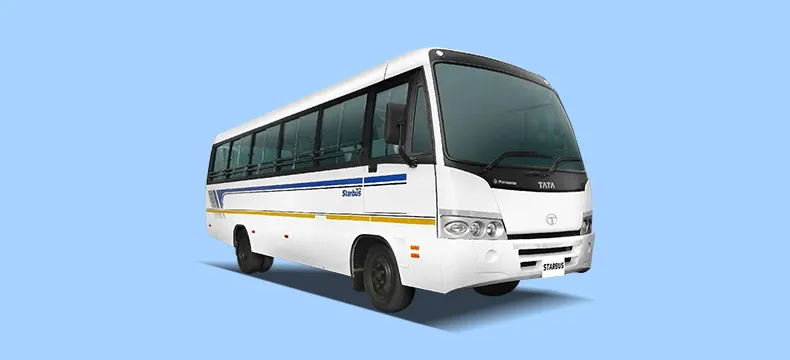11 Mar 2025

What is a Medium Commercial Vehicle and Should You Buy One?
- Tata Motors
- 26 Sep 2024
- Commercial Vechicle
Introduction
If you are in the market for a vehicle to support your business operations, you might have come across the term medium commercial vehicle. Understanding what medium commercial vehicles are is crucial for making an informed decision on which truck you should buy.
This article will delve into the medium commercial vehicle meaning, provide a comprehensive medium commercial vehicle definition, and explore the medium commercial vehicle specifications. Additionally, we will discuss the benefits of medium trucks and offer a commercial vehicle purchasing guide to help you decide if a medium commercial vehicle is right for you.
Understanding Medium Commercial Vehicles
-
Definition and Size:
Medium commercial vehicles (MCVs) typically fall between light and heavy commercial vehicles in size and payload capacity. They handle substantial loads while remaining more maneuverable and fuel-efficient than heavy-duty trucks.
-
Versatility:
MCVs are used in various industries, from construction and logistics to agriculture and retail, due to their ability to transport goods over medium distances efficiently.
-
Specifications:
Common features of MCVs include robust chassis, powerful engines, and advanced suspension systems, ensuring they can handle various terrains and loads.
-
Safety Features:
Modern MCVs often come equipped with safety features like anti-lock braking systems (ABS). Additionally, most trucks also have electronic stability control (ESC) and advanced driver assistance systems (ADAS).
-
Cost-Effectiveness:
MCVs offer a balance between payload capacity and fuel efficiency, carrying heavier loads than light trucks without the high operational costs associated with heavy trucks.
-
Manoeuvrability:
These vehicles are easier to maneuver in urban environments compared to larger trucks, offering greater flexibility in diverse business applications.
-
Purchasing Considerations:
When selecting an MCV, businesses should evaluate their specific needs, such as the type and volume of goods transported, typical distances covered, and operating conditions, while considering the total cost of ownership, including purchase price, fuel costs, maintenance expenses, and potential resale value.
Popular Medium Commercial Vehicles
Tata Motors LPT 1212 MAX
The Tata Motors LPT 1212 MAX combines unmatched power and efficiency, making it an ideal choice for transporting goods and handling deliveries with ease and precision. Powered by the high-performance Tata 497 CR TCIC, a water-cooled common rail direct injection diesel engine, it delivers a maximum power output of 92 hp at 2400 rpm and a maximum torque of 400 Nm. This ensures smooth driving and optimal fuel efficiency, further enhanced by its GBS-40 synchromesh, 5F + 1R gearbox.
Safety and reliability are paramount with the Tata LPT 1212 MAX, featuring a dual-circuit full-air S-CAM brake system with ABS for responsive braking performance. The semi-elliptical leaf spring suspension at the front and rear provides a smooth ride even on challenging terrains. With a gradeability of 25%, this truck effortlessly handles steep inclines and difficult road conditions.
Specifications
- Engine: Tata 497 TCIC CR
- Engine Type: Water-cooled direct common rail injection diesel
- Engine Capacity: 3783 cc
- Max Power Output: 125 hp @ 2400 rpm
- Torque: 400 Nm @ 1300-1600 rpm
- Gearbox: GBS-40 Synchromesh, 5F+1R
- Clutch: 330mm Dia, Single plate dry friction
- Brakes: Dual Circuit full air S-Cam brakes with ABS
- Suspension: Semi-Elliptical Leaf Springs (Front and Rear)
- Tyre Size: 9.00 R20 - 16PR (Radial)
- Fuel Tank Capacity: 160 L
- Warranty: 1 Year or 64,000 kms, whichever is earlier
Tata Motors LPT 1613
The Tata LPT 1613 is the ultimate commercial vehicle that drives your business forward with power and reliability. Equipped with a powerful 697 TC/IC BSIII Common Rail Diesel Engine, it ensures high mileage and superior savings with 136 hp maximum power. The Tata GBS 600, 6F + 1R gearbox provides strength and control, making it versatile for various industries.
This truck's semi-elliptical leaf spring suspension system guarantees stability and secure transportation, even on challenging terrain. Ideal for transporting agricultural produce, construction materials, or retail inventory, the Tata LPT 1613 Tata LPT 1613 offers versatility and reliability to meet diverse business demands.
Specifications
- Engine: 697 TC/IC Bharat Stage III - COMMON RAIL
- Engine Type: Water-cooled direct injection Turbo charged intercooled Diesel Engine
- Engine Capacity: 5675 cc
- Engine Power: 136 hp at 2500 rpm
- Torque: 490 Nm at 1500 rpm
- Gearbox: Tata GBS 600, 6F + 1R
- Clutch: 352 mm
- Brakes: Full Air S-Cam with Auto slack adjuster, with ABS
- Suspension: Semi-elliptical leaf spring
- Tyre Size: 10 R 20 - 16PR
- Fuel Tank Capacity: 225 L
Future of Medium Commercial Vehicles
-
Electrification and Sustainability:
There is a growing emphasis on electric vehicles (EVs) due to environmental regulations and sustainability goals. Additionally, there is increasing adoption of alternative fuels like CNG and biofuels to reduce carbon footprints. Enhanced battery technology is also contributing to longer ranges and shorter charging times.
-
Connected Vehicles:
Integration of Internet of Things (IoT) technology enables real-time vehicle monitoring and diagnostics. This advancement improves fleet management through data analytics and telematics, leading to enhanced route optimization and predictive maintenance capabilities.
-
Sustainable Manufacturing:
The focus is on eco-friendly manufacturing processes and the use of recyclable materials. This involves collaboration between manufacturers, governments, and technology providers to innovate and implement sustainable practices.
Conclusion
In conclusion, understanding what a medium commercial vehicle is and its associated benefits can significantly impact your business operations. By considering the meaning of medium commercial vehicles and evaluating their specifications, you can make an informed decision. Following a comprehensive commercial vehicle purchasing guide will further help you determine if a medium commercial vehicle is right for you.
Frequently Asked Questions
What defines a medium commercial vehicle, and how does it differ from other categories?
A medium commercial vehicle is defined by its gross vehicle weight rating (GVWR) between 16 and 24 tonnes. It differs from light commercial vehicles, which have a lower payload capacity, and heavy commercial vehicles, which are larger and designed for more substantial loads.
What are the benefits of owning a medium commercial vehicle for business purposes?
The benefits include a balance between payload capacity and fuel efficiency, versatility across various industries, and better manoeuvrability in urban environments compared to heavy trucks.
What are the key performance factors to consider when choosing a medium truck?
Key performance factors include engine power, fuel efficiency, payload capacity, chassis durability, and the availability of advanced safety features.
What maintenance practices are essential for ensuring the longevity of medium commercial vehicles?
Regular maintenance practices include routine inspections, timely servicing of the engine and transmission, checking and replacing fluids, and ensuring the proper functioning of safety systems. Regularly scheduled maintenance and prompt repairs can significantly extend the vehicle's lifespan and resale value.
- Tags





















